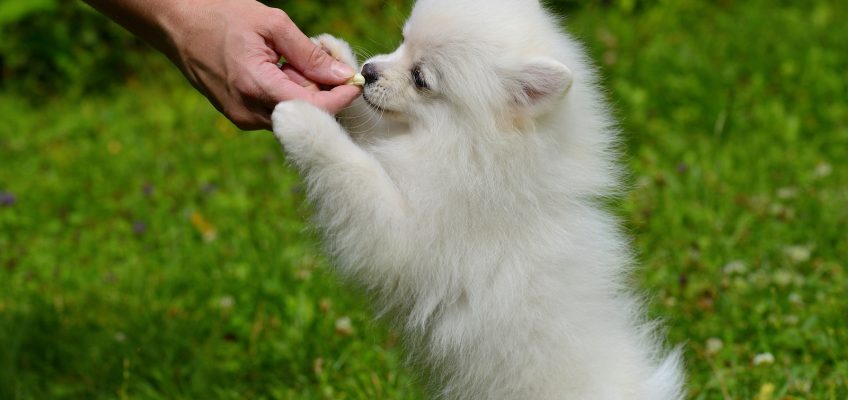Does praise offer more reward than a tasty treat? We ask the experts!
There is little doubt that positive reinforcement is probably the most popular form of animal training in the world. Robert Dollwet, the trainer behind Didga and Boomer, YouTube stars with more than 51 million views to their names, is a staunch supporter of positive reinforcement. Over the last 34 years, it has served him very well: not only has he successfully trained countless dogs and cats, he has also used positive reinforcement to train animal actors in Hollywood. “It’s science based,” he says. “They’ve done extensive studies on how animals think and learn and what is best. I can assure you it’s much fairer and [more] fun for the animal than dominant training techniques.”
So why does positive reinforcement work? It all boils down to rewards. Rewards are given to the animal to reinforce a behaviour. Rewards fall into two categories: praise and treats. The premise is that the more an animal is rewarded for performing a behaviour that is desirable, the more likely it will be that they’ll repeat this behaviour in the future. “Positive reinforcement training is used so widely because it’s the most humane, welfare friendly and fun way to train,” Dr Kate Mornement, animal behaviourist and trainer, says. “Animals actively enjoy learning this way and seem to learn faster.”
Which rewards are best?
The most common rewards used in positive reinforcement training are praise — where a verbal cue such as “good girl” is given immediately after the behaviour has been performed — or tasty treats. Animal behaviourist Kathy Kopellis McLeod says finding the right reward comes down to knowing your pet. “If you have a ball-obsessed dog and you offer them a food treat, you’ve just used a reward that your dog doesn’t like as much. It’s all about knowing your pet well and what makes them tick, using their top reinforcements to receive maximum benefit in minimum time.”
But what if you’re unsure of your pet’s preference? Dr Kate suggests setting up a choice test. “Line up some different rewards including treats and toys and use the reward your dog consistently chooses.”
Can you switch rewards?
While it’s possible to switch from treats to praise, Dr Kate says it’s important to understand what motivates your animal. “Yes, you can switch. The disadvantage of this, though, is that some dogs don’t find praise as rewarding as we think it is,”
she says. “This can result in a loss of motivation. It’s best to pair praise with treats as this increases the value of the praise simply because of its association with food.”
Animal behaviour trainer Jade Fountain believes consistency is important for your pet to learn a new behaviour. “When teaching an animal a new behaviour, it’s a good idea to keep rewarding the behaviour with a single treat each time during the learning phase,” she says. “In many cases, people switch to using a ‘good boy’ in place of a food reward too quickly and the dog may lose interest in training.”
Watch the calories
Trainer Brydie Charlesworth says food treats are fine as long as you take them into consideration when feeding your animal. “The only downside to high-value food rewards is when clients don’t understand portion control and end up with a tubby dog,” she says. ”It’s important to remember that training treats count when it comes to daily calories, and meals need to be adjusted to reflect this.”
Jade agrees. “If you use a handful of treats in a short training session, that is one handful less dinner or breakfast that they need,” she says. “Instead of putting all your dog’s breakfast into a bowl, use some in food puzzle toys such as KONGs and put some food in your treat pouch or pocket to reinforce good behaviour.”
Pros and cons of praise and treats
Finding the best reward for your pet may involve trying a few different things. To make your decision a little easier, here are some pros and cons to consider.
Pros of praise
- It’s available anywhere at any time.
- We already offer praise to our animals; we just need to tweak its use.
- Praise can be given immediately — timing is everything.
Cons of praise
- Some animals are simply not motivated by praise.
- If praise is given too late, the animal may not make the association between the command and the behaviour.
Pros of treats
- Food is a primary reinforcer — it already has an innate biological value to all animals.
- Use of treats increases focus.
Cons of treats
- You won’t always have treats with you.
- Using treats but not adjusting food intake may result in health problems.
- Your pet might not perform until he sees that you’ve got treats/food for him.
Pets are capable of learning innumerable things throughout the course of their lives. Training doesn’t just stop after a skill is mastered — move on and find something else to challenge them with. Having an understanding of what rewards work best means spending time developing and nurturing a strong bond with your pet. And that is positive for everyone.
Written by Kristie Bradfield
Originally in Pets Issue 66


One Response
Libby Ayre
When dogs ard yojng using treats is a great way to get them into doing tricks. With my dog Stormie every time she sat or lay down Syormie would be rewarded.